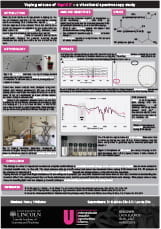by Nancy Whittaker //
 Over the past few years, there has been a huge growth in vaping, i.e. the use of electronic cigarettes for the consumption of both nicotine-containing and nicotine-free liquids (“e-liquids”) that are vapourised to be inhaled. Public Health England has deemed it as a healthier alternative to tobacco smoking based on the lack of tar containing substances. There are variety of e-liquids for intented use available on the market, however, news reports reveal that vaping has become a vehicle for nuanced uses such as shampoo and fruit juices. The rise of vaping misuse also sees the introduction of illegal drugs into e-liquids, such as cannabis and synthetic cannabinoids. This has been sparsely documented in studies yet more so in tabloid news outlets. It is very likely that the extent of misuse in this way is just the tip of the ice berg. Recipes for e-liquids involving illegal substances are easily accessible on the internet for any user.
Over the past few years, there has been a huge growth in vaping, i.e. the use of electronic cigarettes for the consumption of both nicotine-containing and nicotine-free liquids (“e-liquids”) that are vapourised to be inhaled. Public Health England has deemed it as a healthier alternative to tobacco smoking based on the lack of tar containing substances. There are variety of e-liquids for intented use available on the market, however, news reports reveal that vaping has become a vehicle for nuanced uses such as shampoo and fruit juices. The rise of vaping misuse also sees the introduction of illegal drugs into e-liquids, such as cannabis and synthetic cannabinoids. This has been sparsely documented in studies yet more so in tabloid news outlets. It is very likely that the extent of misuse in this way is just the tip of the ice berg. Recipes for e-liquids involving illegal substances are easily accessible on the internet for any user.
My research project investigated vaping of e-liquids laced with the controlled substances gamma-hydroxybutyrate (GHB, “liquid X”) and its precursor gamma-butyrolactone (GBL, “Insom-X”) using both Raman and Infrared spectroscopy (IR) for analysis. Analyses of samples were carried out both pre and post vaping to investigate the effect of the vaping mechanics on the chemical profile of the studied e-liquids. Furthermore, prolonged vaping use was a focus of my work by repeatedly vaping e-liquids such as a user might do.
During the experimental stages of the project I encountered a few challenges relating to the vaping set-up and data collection. After investigating through online research and talking to my peers as well as my supervisors, I managed to optimise the laboratory set-up for safe vaping simulation by exploring a variety of options both on e-cigarette settings as well as laboratory equipment set-up. I gained experience that built on my undergraduate degree and was able to become proficient in simulating vaping.
In collaboration with my supervisor and technician, I was able to learn analytical instrumentation to a much deeper level than I was previously taught during my undergraduate studies. This enabled me to work independently alongside postgraduate researchers during the project period. I greatly enjoyed this experience as it gave me an unprecedented view on postgraduate research life. I have since applied for my own postgraduate studies hoping to continue my professional development in analytical chemistry.
Additionally, I learned advanced ways to process the data I had obtained from the analytical instruments I used for this project. This not only deepened my understanding for this project but will further my ability for analytical chemistry research, and I envisage it will support me immensely during my postgraduate studies, and hopefully after that.
*To view Nancy’s project poster, please click on the thumbnail below:
